Mastering Effective Watering Techniques for Your Garden

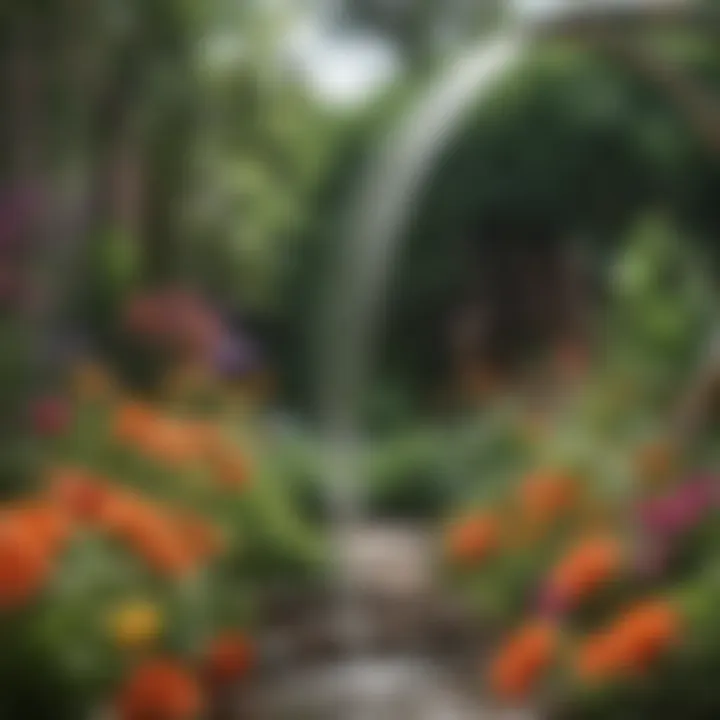
Intro
Watering plants is a fundamental aspect of maintaining a healthy garden. To cultivate vibrant and resilient flora, understanding various watering techniques is essential. The processes involved can significantly impact plant health, growth, and productivity. Homeowners and gardening enthusiasts must grasp the methodologies that promote optimal hydration for different plant species and environmental conditions. This deep dive into effective watering techniques will cover everything from traditional methods to the latest technological advancements.
Knowing when to water, how much to use, and the best practices for specific types of plants will enhance your gardening experience. This article aims to provide insights that cater to diverse needs and preferences. By doing so, you will be better equipped to create and maintain a thriving garden that not only flourishes but also contributes to the beauty of the surrounding environment.
Designing Watering Strategies
Given the significance of water availability, designing effective watering strategies is key. An informed approach considers various elements, including climate, soil conditions, and plant types.
Current Trends in Irrigation
Modern gardening is shifting towards incorporating technology in irrigation systems. Homeowners are interested in techniques like drip irrigation and rainwater harvesting. These methods conserve water while ensuring plants receive the right amount of moisture. Moreover, smart irrigation systems enable users to monitor and control watering schedules remotely, adjusting for fluctuations in weather.
Color Schemes in Garden Layout
While not directly related to watering, thoughtful garden design influences moisture retention. The choice of planting layouts and plant combinations can affect how water travels through the space. Using mulches and ground covers can also aid in retaining soil moisture, reducing the frequency of watering. Understanding how to design a garden that balances aesthetics with effective water use can elevate both the appearance and health of your green space.
Gardening Techniques
Effective watering techniques are enhanced when paired with proper gardening methods. Choosing the right plants for your environment is crucial, as it determines the hydration needs of your garden.
Plant Selection and Care
Selecting plants that suit your climate and soil conditions can minimize watering requirements. Native plants, for example, often thrive with less water, as they are adapted to local conditions. Familiarizing yourself with each plant's specific needs will lead to better care and results. Furthermore, regular maintenance practices like pruning and mulching can help manage moisture levels more effectively.
Indoor vs. Outdoor Gardening
There are distinct differences in watering needs between indoor and outdoor gardens. Indoor plants generally require more frequent and careful monitoring of moisture levels, as they are often exposed to different humidity levels and light conditions than outdoor plants. Conversely, outdoor gardening allows for more natural rainwater absorption, though it also comes with its challenges, such as evaporation and drainage concerns.
Engaging with this content will offer you a broader knowledge base. This will empower you to adopt innovative and traditional watering practices tailored for your garden's specific requirements.
Prologue to Plant Hydration
Water is the lifeblood of any garden. Understanding plant hydration is crucial for anyone looking to cultivate a thriving garden. Plants, similar to all living organisms, require water to survive and grow. Water plays significant roles in photosynthesis, nutrient transport, and temperature regulation for plants. Therefore, knowing how to hydrate plants properly can make a considerable difference in their health and productivity.
One of the primary benefits of effective watering is promoting robust root systems. Deep watering encourages roots to grow further into the soil, enabling them to access more nutrients and moisture. Shallow watering, on the other hand, can lead to weak roots that do not thrive, which exposes plants to drought and health issues.
Considerations regarding plant hydration also extend beyond just the act of watering itself. Factors like weather conditions, time of day, and the specific needs of different species can all impact how and when to water effectively. For example:
- Soil composition affects how quickly water drains or retains moisture.
- Climate differences necessitate varying watering schedules; regions with higher temperatures may require more frequent watering.
- Plant types have distinct hydration needs, where succulents typically need less water than ferns.
By comprehending these elements, homeowners and gardening enthusiasts can optimize their watering techniques, ensuring that plants receive adequate hydration without wastage. In the sections that follow, we will explore practical methods and technological solutions to enhance watering efficiency. This knowledge can lead to a more sustainable gardening practice, resulting in healthier plants and a more vibrant garden overall.
The Importance of Proper Watering
Proper watering is foundational to the health and vitality of any garden. It influences plant growth, flowering, and fruiting. Without sufficient water, plants can exhibit stress, leading to wilting, yellowing leaves, and limited growth. On the other hand, overwatering presents its own issues, such as root rot and fungal diseases.
Benefits of Proper Watering
Ensuring plants receive the correct amount of water contributes significantly to their overall well-being. Here are key benefits:
- Enhanced Growth: Adequate moisture promotes efficient nutrient absorption, allowing plants to grow robustly.
- Improved Resilience: Well-hydrated plants can better withstand pests, diseases, and environmental stressors.
- Fertility Optimization: Proper watering facilitates the uptake of essential minerals and nutrients contained in the soil.
Correct hydration is not just about quantity; timing, the type of watering technique, and understanding soil composition also affect how effectively water is delivered to plants.
Considerations for Effective Watering
Several factors impact effective watering practices:
- Soil Type: Different soil types hold moisture in varying capacities. Sandy soils drain quickly, while clay soils retain water. Understanding your garden’s soil composition is crucial for determining watering needs.
- Plant Type: Each plant species has unique hydration requirements. For example, succulent plants require significantly less water than tropical plants.
- Environmental Factors: Weather conditions play a role as well. Hot, windy days may necessitate more frequent watering than cooler, overcast days.
"Understanding the balance between watering too much and too little is key to a successful garden."
The relevance of proper watering cannot be overstated. Correct hydration techniques optimize thriving plants and yield high-quality produce.
In summary, acknowledging the importance of proper watering is essential for any gardener. It encapsulates the science of plant care and practically guides gardeners toward enhanced growth and development. Integrating thoughtful watering techniques into your gardening routine can sustain a vibrant and fruitful garden.
Understanding Soil Composition
Soil composition plays a crucial role in how effectively water is managed in your garden. It determines how water flows, how much it retains, and how available it is to plants. Understanding the properties of soil will lead to better watering practices and healthier plants. Without a solid grasp of soil composition, one might either overwater or underwater plants, leading to poor growth.
Types of Soil
There are three main types of soil: sand, silt, and clay. Each type has unique features that affect water drainage and retention.
- Sand: This type has large particles and drains water quickly. While it allows for good aeration, it does not hold nutrients well.
- Silt: With smaller particles, silty soil retains more water than sandy soil while still offering good drainage. It tends to be more fertile, making it suitable for many plants.
- Clay: Clay soil has very small particles that stick together tightly. It retains water effectively but can lead to poor drainage and root rot if overwatered.
Understanding these types allows gardeners to choose appropriate watering methods. For instance, sandy soil requires more frequent watering than clay, which may need less water but in larger amounts.
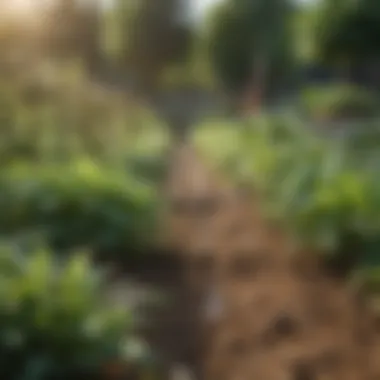
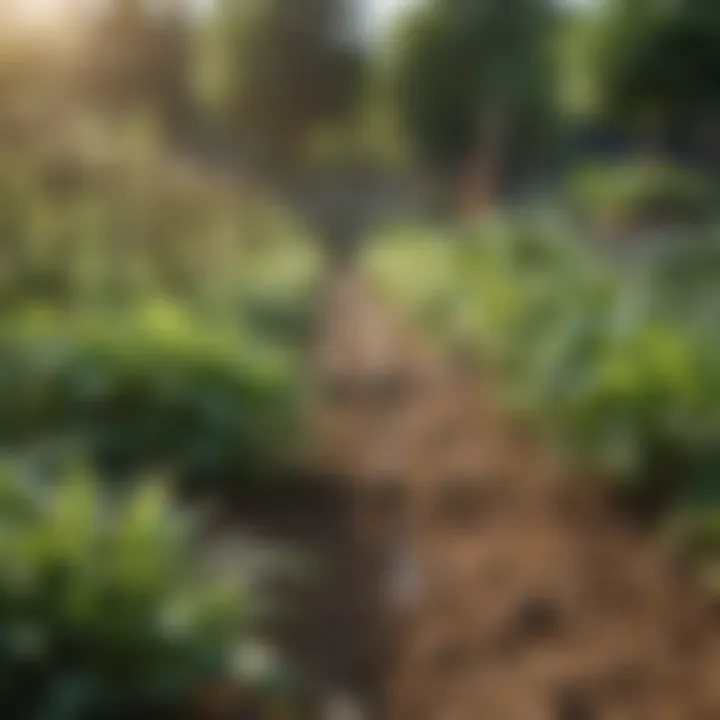
Soil Drainage Characteristics
Soil drainage is an important aspect of gardening as it affects the availability of water to plants.
- Well-draining Soil: This type allows excess water to flow away, preventing waterlogging. Plants in well-draining soil are less likely to suffer from root rot.
- Poorly-draining Soil: This can lead to various issues such as water pooling on the surface or saturated roots. Gardeners need to be cautious with watering schedules in these areas to avoid devastating effects on plant health.
Factors such as soil texture, structure, and organic matter content all influence drainage characteristics. For example, mixing organic materials with clay can improve its drainage. Regular testing can help determine the drainage capability of your soil.
"Proper soil understanding can significantly enhance watering strategies and optimize plant health."
Watering Techniques Overview
Watering techniques play a crucial role in maintaining a healthy garden. The right method depends on various factors such as the types of plants, soil composition, and local climate. Understanding these techniques allows gardeners to enhance plant growth and conserve water. Watering techniques can also impact soil health, encouraging deeper root growth and reducing the risk of diseases caused by excess moisture.
Each watering method has its advantages and considerations. For example, hand watering provides precise control but can be time-consuming. In contrast, automated irrigation systems save time and ensure consistent moisture but require a higher initial investment. It's important to evaluate the specific needs of your garden when choosing the appropriate technique.
Hand Watering
Hand watering is one of the most direct and controllable methods for providing plants with the moisture they need. Using a watering can or hose, gardeners can target specific plants, ensuring they receive the right amount of water without wastage. This method is particularly useful for small gardens or container plants.
While hand watering may seem labor-intensive, it allows for close observation of plant health. Gardeners can notice signs of distress, such as wilting or discoloration while watering. Additionally, this technique encourages mindfulness and connection with the garden.
Drip Irrigation
Drip irrigation is an efficient method that slowly delivers water directly to the roots of the plants. It uses a system of tubing with emitters that release water at a controlled rate. This method reduces evaporation losses and minimizes runoff, making it a highly effective approach in arid environments.
Drip irrigation can be easily customized based on the specific requirements of different plants in the garden. However, it does require some initial setup, including the cost of materials and time for installation. Maintenance is also necessary to prevent clogging of emitters.
Soaker Hoses
Soaker hoses offer another efficient watering solution, particularly for garden beds. These hoses, made with porous material, release water evenly along their length when connected to a water source. This method helps conserve water while providing a consistent and gentle soak to plants, reducing the risk of overwatering.
Soaker hoses are ideal for rows of vegetables or flowers, allowing water to seep into the soil directly where it is needed. They can be left in place for an extended period, making them convenient for busy gardeners. However, they may need periodic checks to ensure proper function and drainage.
Sprinkler Systems
Sprinkler systems are more suited for larger gardens and lawns. They distribute water over a wider area, which is beneficial in maintaining even moisture levels in grassy or expansive plots. Sprinklers can be stationary or mobile, and some modern systems can be automated, allowing for scheduled watering.
Though effective for large areas, sprinkler systems often lead to water loss from evaporation, particularly in hot climates. It’s essential to choose the right type of sprinkler based on the garden layout and the specific water needs of various plants.
"A proper watering technique not only nurtures plant health but also contributes to responsible water usage.”
Timing Your Watering
The timing of irrigation can be as significant as the method of watering itself. Understanding when to water is crucial for maximizing the benefits of water application and promoting healthy plant growth. Timing influences not only how much water reaches the roots but also how effectively plants can use that water. Watering at the right time can help prevent disease, minimize evaporation, and promote deeper root growth.
Best Times to Water
Watering early in the morning is generally considered optimal for several reasons. At this time, temperatures are cooler, which reduces evaporation losses. The leaves are generally dry during morning hours, which decreases the risk of fungal diseases that can be exacerbated by wet conditions. Additionally, this timing allows plants to absorb moisture throughout the day, sustaining them as temperatures climb.
However, if morning watering is not feasible, late afternoon can be a second-best option. This timing allows the water to absorb into the ground before sunset, reducing evaporation compared to midday watering. Be cautious, though: if leaves remain wet overnight, it can promote disease.
Some homeowners may wonder if watering at night is effective. While it may seem logical, nighttime irrigation can lead to dampness for extended periods, which can encourage mold and other pathogens on plant surfaces.
Seasonal Variations
Timing should also adapt with seasonal changes. During hotter months, plants typically need more frequent watering due to increased evaporation and higher growth rates. It is essential to monitor the weather and adjust watering schedules accordingly, especially during heatwaves when temperature spikes occur.
In contrast, during cooler months, especially in regions where frost is common, plants require less water. Depending on local climate, it may even be necessary to water less frequently as many plants enter a dormant phase and their water needs decline.
Proper watering timing is a blend of environmental observation and understanding plant biology. Favorites like tomatoes may thrive during certain times and need additional care during extreme conditions.
Common Watering Mistakes
Understanding common watering mistakes is crucial for anyone looking to maintain a thriving garden. Proper hydration is not just about how much water you administer; it's about ensuring that the water is applied in a way that meets the specific needs of your plants. Many gardeners, whether novice or experienced, can easily fall into the trap of misjudging their approach. This section will explore the two main errors: overwatering and underwatering, highlighting their implications and offering guidance for rectification.
Overwatering
Overwatering is one of the most prevalent mistakes jardiners make. When plants are given too much water, it can lead to a variety of complications. Root rot is a common outcome, where the roots start to decay due to a lack of oxygen. This can setting off a whole series of health issues for the plant. Additionally, overwatered plants might become susceptible to fungal infections and other pests, jeopardizing their overall health.
Several signs indicate that you may be overwatering:
- Yellowing leaves: Leaves often change color when roots cannot take up nutrients effectively.
- Wilting: Paradoxically, overwatered plants can also exhibit wilting as their roots become compromised.
- Soggy soil: If the soil remains overly wet for extended periods, this indicates excess moisture.
To avoid overwatering, consider the following strategies:
- Always check the soil moisture before watering. Insert your finger about an inch into the soil. If it feels moist, postpone further watering.
- Use well-draining soil. This helps ensure that excess water can escape rather than pooling around the roots.
- Adjust your watering schedule according to the weather. Hot, windy days may require more frequent watering, while cooler, cloudy days may not.
"Proper watering is essential for plant health. Overwatering can be as detrimental as underwatering."
Underwatering
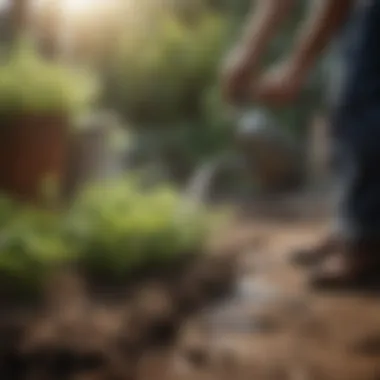
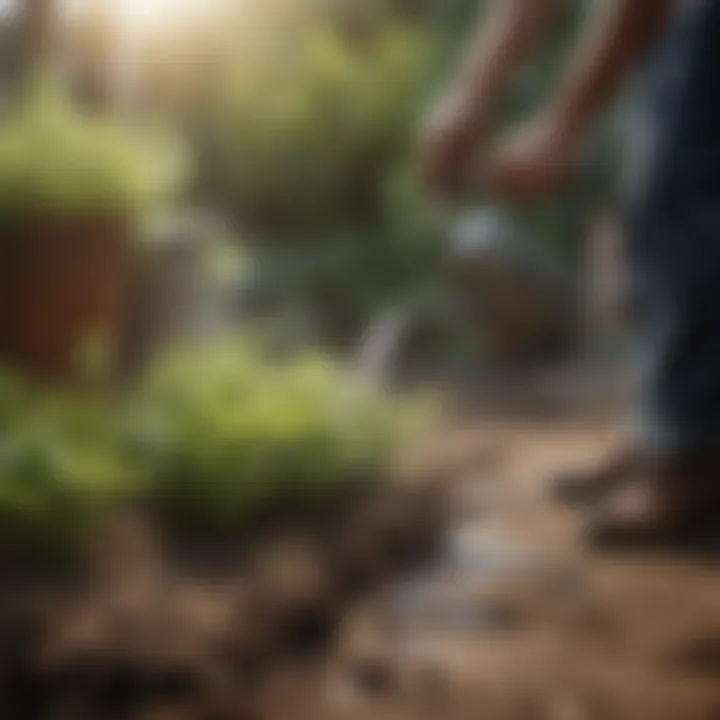
On the flip side, underwatering can also have severe consequences. When plants do not receive enough water, they experience stress, which can stunt their growth. If left unchecked, plants might become wilted and drop their leaves, indicating a desperate need for hydration. The soil can turn hard, making it difficult for roots to absorb enough moisture.
Signs of underwatering include:
- Crispy leaf edges: Leaves can become dry and brown, a leading indicator of insufficient water.
- Drooping foliage: Plants may sag as they lack the necessary moisture to maintain their structure.
- Cracked soil: Drought conditions often lead to soil that is cracked and dry.
To remedy underwatering, the following practices can help:
- Set a consistent watering schedule based on your plant species and local climate.
- Mulch around your plants to help retain soil moisture.
- Water deeply but less frequently. This encourages roots to grow deeper, improving your plant’s drought resistance.
Technological Advances in Irrigation
The realm of gardening and plant care is witnessing remarkable innovations. As homeowners become more conscious about sustainability and water usage, integrating technological advances into irrigation practices has become essential. These methods not only conserve water but also optimize plant health effectively. By leveraging these advancements, gardeners can monitor and control their watering strategies in a more efficient way, resulting in healthier and more vibrant gardens.
Smart Irrigation Systems
Smart irrigation systems have revolutionized how we approach watering our gardens. Unlike traditional systems that operate on a fixed schedule, smart systems adapt according to weather conditions, soil moisture levels, and individual plant requirements.
These systems often work via timers and sensors, which allow the irrigation to be adjusted automatically. This capability can significantly reduce water waste, as it avoids unnecessary watering during periods of rainfall or when the soil is adequately moist. Moreover, many smart irrigation systems can be controlled remotely using mobile applications. This provides gardeners with the flexibility to adjust watering schedules and monitor conditions, ensuring their plants receive the optimal amount of water they need.
Benefits of Smart Irrigation Systems:
- Water Conservation: Minimized overwatering leads to lower water bills and more efficient usage.
- Healthier Plants: Consistent moisture levels promote better root development.
- Convenience: Remote management simplifies the watering process.
- Data Insights: Some systems provide insights into plant health and soil conditions, improving your gardening strategy.
Soil Moisture Sensor Technology
Soil moisture sensor technology is another significant advancement in irrigation. These devices measure the water content in the soil, providing real-time data on moisture levels. This information is invaluable for gardeners aiming to fine-tune their watering practices.
By using soil moisture sensors, you can optimize the timing and quantity of water applied. The sensors can trigger automatic watering when the soil becomes too dry, ensuring that plants are never underwatered or overwatered. This precision fosters a healthier growing environment, as plants thrive when they receive the right amount of water consistently.
Key Considerations for Soil Moisture Sensors:
- Types of Sensors: Understand the types available, such as resistive, capacitive, or tensiometer-based sensors.
- Placement: Proper placement of sensors ensures accurate readings and effective irrigation control.
- Integration with Smart Systems: Combining sensors with smart irrigation systems creates a comprehensive watering solution.
Factors Influencing Water Needs
Understanding the factors that influence the water needs of plants is crucial for ensuring optimal hydration and, ultimately, plant health. Each garden is unique, and the interaction of several environmental and biological elements affects how much water is necessary for thriving plants. By considering these factors, gardeners can tailor their watering strategies to match the specific conditions of their gardens, promoting robust growth and sustainability.
Climate and Weather Conditions
Climate plays a key role in determining how much water plants require. In hot and dry regions, evaporation rates are significantly higher, leading to increased water needs. When temperatures soar, plants transpire more, drawing moisture from the soil. Conversely, in cooler and wetter climates, less frequent watering is often sufficient because the soil retains moisture for longer periods.
Weather conditions also can create fluctuations in planting water requirements. For example, after a heavy rainfall, the immediate need for watering decreases substantially. On the other hand, during a prolonged drought, gardeners must reassess their irrigation strategies to ensure plants do not suffer from dehydration.
"The interaction of climate and transient weather elements makes it difficult to establish a one-size-fits-all watering schedule."
Plant Species Considerations
Different plants have varying water needs based on their species and inherent characteristics. For instance, succulents typically require less water compared to tropical plants. Understanding specific plant types helps in creating an effective watering schedule. Researching each plant's native environment can provide insights into how much moisture they instinctively need.
Considerations should include:
- Drought Tolerance: Some plants, like lavender, can withstand dry spells, while others, such as ferns, thrive in moist conditions.
- Growth Stage: Young plants often need more water as they establish their root systems, whereas mature plants may require less frequent watering.
- Foliage Type: Plants with larger leaves often lose more water through transpiration and may need more frequent watering.
Garden Layout and Placement
The layout and placement of plants in your garden profoundly impact their watering needs. Sun exposure, wind, and proximity to other plants can either enhance or hinder moisture retention. For example, plants placed in shaded areas may require less water due to reduced evaporation, whereas those in full sun may need more.
Key factors to consider include:
- Grouping Plants: Arrange plants with similar water needs together. This practice optimizes watering efficiency.
- Elevation: Raised beds may drain more quickly, leading to faster moisture loss, and thus may require more frequent watering.
- Soil Type and Mulching: Different soil types have unique drainage capabilities. Sandy soils drain quickly, while clay holds moisture well. Mulching can help retain moisture in the soil, reducing the frequency of watering.
By integrating these factors into their gardening strategies, homeowners can enhance their plants' hydration, promoting healthier and more attractive gardens.
Watering Specific Plants
Watering specific plants is a crucial aspect of maintaining a healthy garden. Each type of plant has its own requirements when it comes to water intake. Understanding these needs can lead to a more effective watering routine that promotes growth and reduces waste. Plants like vegetables and flowers require different amounts of water and may have distinct responses to watering styles. This section delves into these specific plants, providing insights into their unique watering needs and techniques.
Vegetable Gardens
Vegetable gardens are both rewarding and demanding. The water requirements for vegetables vary considerably among different species. For instance, tomatoes and cucumbers require more water than carrots or potatoes. Insufficient watering can result in stunted growth and poor yields, while overwatering creates risks for root rot and diseases. The best practice is to water deeply and less frequently. This encourages the roots to grow deeper into the soil, which in turn increases drought resistance.
To ensure optimal hydration for your vegetable garden:
- Aim to provide at least 1 inch of water per week, adjusting based on rainfall.
- Water early in the morning or later in the afternoon to minimize evaporation.
- Use soaker hoses or drip irrigation to deliver water directly to the soil.
By focusing on the specific water needs of vegetables, homeowners can create a thriving vegetable garden.
Flower Gardens

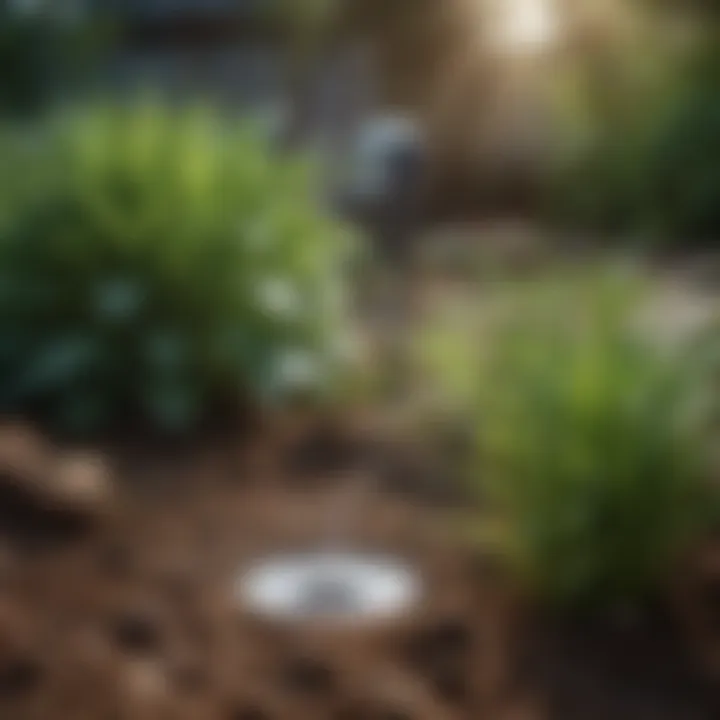
Flower gardens present another layer of complexity when it comes to watering. Different types of flowers have individual requirements based on their species. Perennials typically require less water than annuals. Additionally, flowering plants like petunias need consistent moisture, while others like lavender prefer drier conditions.
To maintain a healthy flower garden, consider the following:
- Mulch around plants to retain moisture and reduce weed growth.
- Adjust watering schedules during flowering seasons to prevent wilting or blooms from dropping.
- Regularly inspect soil moisture levels; a simple finger test can determine if the soil feels dry an inch below the surface.
Properly watering flowers not only enhances their beauty but also strengthens their resilience against pests and diseases.
Ornamental Shrubs
Ornamental shrubs add texture and structure to a garden, but they too require specific care when it comes to watering. Young shrubs need regular moisture while establishing their root systems. As they mature, their water needs reduce, but some species may still require more water than others. Evergreen shrubs often need more moisture than deciduous ones during dry spells.
Key tips for watering ornamental shrubs include:
- Providing supplemental water during extended dry periods, especially in the first couple of years.
- Avoiding watering directly onto the foliage to prevent mold and mildew.
- Utilizing a slow, deep watering technique to promote root growth.
By understanding these specific watering practices, one can ensure the longevity and health of ornamental shrubs in the garden.
Water Conservation Strategies
Water conservation plays a critical role in effective gardening. By using water efficiently, gardeners not only sustain their plants but also contribute to a broader environmental effort. The focus on conserving water helps in minimizing waste and ensures resources are used responsibly. Effective strategies can also lead to healthier plants and can reduce dependence on external water sources, especially during dry periods.
Rainwater Harvesting
Rainwater harvesting is the collection and storage of rainwater for future use. This technique is not only sustainable but serves as a cost-effective way to ensure gardens receive adequate moisture. Homeowners can easily set up a system to channel rainwater from roofs into storage barrels or tanks. This method captures water that would otherwise run off, allowing gardeners to make the most of this natural resource.
Benefits of Rainwater Harvesting:
- Cost Savings: Reduces water bills significantly.
- Nutrient-Rich: Collected rainwater is often free from chemicals and is better for plant health.
- Ecosystem Support: Helps in recharging groundwater and preventing surface runoff.
When implementing a rainwater harvesting system, one should consider the following factors:
- Select the right location for collection, ideally a space that receives ample rainfall.
- Choose a suitable storage solution that can scale to the amount of anticipated rainfall.
- Regular maintenance of the system is vital to prevent contaminants and ensure purity of water.
Mulching Techniques
Mulching is a well-known practice among gardening enthusiasts. It involves covering the soil around plants with a protective layer of material. This approach assists in conserving soil moisture, reducing evaporation, and regulating soil temperature. There are various materials one can use for mulching, including organic options like straw or wood chips and inorganic options like plastic sheeting.
Advantages of Mulching:
- Moisture Retention: Limits water loss by creating a barrier against evaporation.
- Weed Control: Suppresses the growth of weeds that compete for moisture and nutrients.
- Soil Health: Organic mulches break down slowly, enriching the soil with nutrients over time.
When mulching your plants, consider the following:
- Apply a layer of 2 to 4 inches to achieve maximum benefits.
- Ensure the mulch material is free from pests and diseases.
- Adjust the type of mulch based on plant needs and local climate conditions.
By integrating rainwater harvesting and effective mulching techniques into gardening routines, homeowners can not only conserve water but also maximize the health and resilience of their gardens.
Maintaining Watering Equipment
Maintaining watering equipment is crucial for any gardener who aims to optimize their plant health and water efficiency. Well-maintained equipment ensures that plants receive the precise amount of water they need, without waste. Regular upkeep enhances the longevity of tools and systems, saving money in the long run and preventing frustrations related to malfunctioning equipment.
Key benefits of maintaining watering equipment include:
- Efficiency: Properly functioning systems deliver water more effectively, reducing the risk of over or under-watering.
- Cost Savings: Regular maintenance often avoids costly repairs or replacements.
- Convenience: Well-maintained tools reduce downtime and ensure that watering tasks go smoothly.
- Healthier Plants: Optimal water delivery contributes to robust plant growth and overall garden vitality.
Regular Inspections
Conducting regular inspections of your watering equipment is essential. This practice not only prevents problems from escalating but also allows for immediate address of any issues discovered. During these inspections, focus on the following aspects:
- Check for Leaks: Identify leaks in hoses or fittings. Even small leaks can lead to significant water loss over time.
- Inspect Connections: Ensure that connections between hoses and sprinkler heads are tight and secure.
- Evaluate Water Pressure: Changes in water pressure can indicate blockages or issues within the system.
Regular inspections can help you catch potential issues early. Set a schedule, such as every few weeks during the watering season, to make this a routine task.
Cleaning and Repairing Irregularities
Cleaning and repairing watering equipment is vital for maintaining optimal performance. Here are some steps and considerations:
- Cleaning Filters: Sprinkler systems and drip irrigation setups typically include filters that can become clogged. Regularly clean these filters to maintain adequate water flow.
- Hose Maintenance: Check hoses for kinks or blockages. A simple cleaning of the inside can prevent water pressure loss.
- Repair Damaged Components: If any parts are visibly damaged or showing wear, they should be repaired or replaced promptly to maintain proper function.
Implementing a cleaning routine involves the following steps:
- Disconnect hoses and systems before cleaning.
- Use a gentle scrub brush to remove any buildup from nozzles and filters.
- Rinse thoroughly to remove debris and ensure the function of all components.
End and Recommendations
The conclusion of any gardening article serves as a vital reflection on the information presented and a guide for future practices. In this piece, we explored various effective watering techniques crucial for maintaining the health of your garden. Proper hydration is not merely about watering plants; it encompasses understanding their needs, adapting methods to suit distinct conditions, and employing technology when possible.
Key Takeaways:
- Assessing Plant Watering Needs: Each plant species has specific water requirements. Knowing these needs allows for tailored watering practices.
- Innovative Techniques: Utilizing methods like drip irrigation and smart irrigation systems not only conserves water but also ensures consistent moisture levels.
- Seasonal Adjustments: As the seasons change, so do water requirements. Regular assessment of climate conditions will help adjust your watering schedule.
- Maintenance of Equipment: Keeping irrigation systems in good condition prevents leaks and ensures efficiency. Regular inspections can save both water and money.
By integrating these recommendations into your gardening routine, you will likely see improvements in plant growth and overall garden aesthetics. Remember that consistency is key. Regularly re-evaluate your watering practices based on environmental changes and plant responses, ensuring that your garden will thrive throughout the seasons.
Ultimately, investing effort into understanding effective watering techniques not only enhances the health and vibrancy of your garden but also contributes positively to the environment. Adopting water conservation strategies will lead to a sustainable gardening practice.
"Consistent care and adaptation to changing conditions are fundamental for a successful garden."



